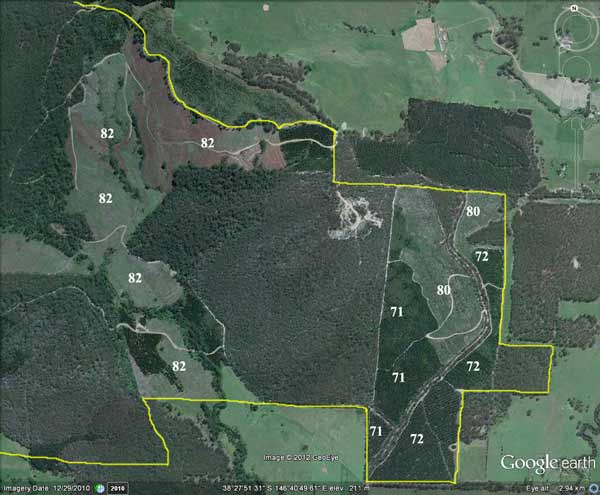

2010 Google Earth image of plantation LEGL93-98 (land within yellow lines), a high portion of which is native forest (~230 ha). Numbers on image indicate when original plantation was established, indicating that 1980 and 1982 saw the most land converted to plantation (~120 ha).
Almost 50ha of plantation was also established 1971/2, most likely with the use of the herbicide 2,4,5-T used at 1.1 L/ha with 50 L/ha diesel.
Plantations established between 1980/2 (`~120ha) were most likely established with a concoction of Amitrole (Weedagol T.L. Plus) and (Gesaprim 500) Atrazine. In 2002 scientists in the United States found that Atrazine at levels as low of 0.1part per billion altered hormones in frogs. Since then Atrazine has been found to have the same effect across a range of animals. 120ha would probably have been sprayed with the Atrazine (4 l/ha/Amitrole 7l/ha) mixture. Totals 480 litres Atrazine, 840 litres Amitrole). The highest risk years for drinking water quality would have been between 1980-4. For more information on more herbicide use in Macks Creek see here.
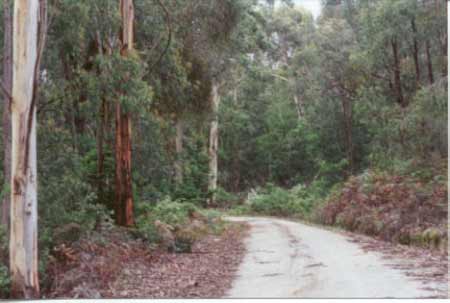
Herbicides Used by Grand Ridge Plantations - Strzelecki Ranges and Gippsland Victoria
| Herbicide | Label Rate max as kg/ha | Used to control | Euc/Rad | Notes | Application |
| Clopyralid | 2.55 | Woody Weeds | Radiata and Eucalypts | Highly Toxic/Potential Ground water Contaminant | aerial or ground |
| Glufosinate Ammonium | 1 | Woody Weeds | Radiata | aerial or ground | |
| Glyphosate | 3.6 | Herbaceous and woody weeds, noxious weeds | Radiata, Eucalpts and Custodial | ||
| Haloxyfop-methyl | 0.13 | Annual and Pernneial Grasses | Eucalypts | Carcinogen | aerial or ground |
| Hexazinone | 4 | Woody Weeds | Radiata | Ground Water Contaminant | Aerial, ground, spot |
| Metsulfuron-Methyl | 0.06 | Woody Weeds, Noxious Weeds | Radiata, Eucalyptus and Custodial | Potential Ground Water Contaminant | Aerial, ground or spot |
| Sulfometuron Methyl | 0.6 | Annual and Perennial Grasses and broadleaf weeds | Eucalyptus | Potential Ground Water Contaminant | Aerial or Ground |
Responsible Authority: Wellington Shire Council
Plantation Catchment: Tributaries of Macks Creek. Tarra River catchment.
Catchment Managment Authority: West Gippsland Catchment Management Authority
Soils for plantation according to 1978 Carrujung Geological Survey Maps:
Tph: Pliocene: Clayey and sandy gravel and coarse sand, minor clay, fine sand and silt. Ferruginization, cross-bedding common. Includes subsurface, the Boisdale Formation and marine equivalents, gravel sand, coquina, marl, clay, peat and brown coal.
Tvo: Palaeocene/Eocene: Dense augite and olivine basalt, tuff, claystone and siltstone. Often extremely weathered and ferruginized.
Qra: Recent Alluvial: Stream alluvium and very low terraces. Buff to dark grey, often carbonaceous clay, silt and fine sand; minor red basaltic clay and basaltic pebbles, quartz sand and peat.
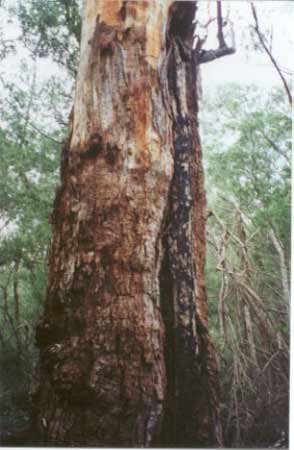
October 2001: Old growth near Sutton Road in Hancock plantation
Hancock Watch Site Visit October 01: This supposed pine plantation is located about 2-3 km west of the village of Wonwron. Its northern and eastern section is bounded by Yarram Blackwarry Road, with Sutton Road bounding the plantations’ southern boundary. It adjoins plantation 93-97 on its western edge. The plantation consists of 1982 radiata pine on its western and southern sides, with older radiata pine along the eastern boundary. At least half of the plantation appears to consist of native vegetation which includes some old growth Banksia Serrata? and old growth eucalypts. The area appears to have been selectively cut early last century with some of the older trees obviously predating the selective cuts. Younger Eucalypts also dominate the area of native vegetation which extends south from Suttons Road through to Yarram Blackwarry Road, a distance of greater than 1km. This native vegetation area extends for almost 1.5km in a westerly/easterly direction and is obviously of high conservation importance in an area dominated by radiata pine and farmland. More work needs to be done identifying key species in this remnant woodland. It is most likely rare to have eucalypt/banksia dominated forest ecotones outside of the Mullungdung region. Some pine harvesting was occurring on flat land near the tributaries of Macks Creek. Several tributaries were heavily infested with English Ivy and buffer zones were minimal.
Hancock Watch site visit November 01: Evident from Bulga Park Road south west of the plantation that there is some regenerating native vegetation south of the old shire of Alberton Quarry which is most likely to be of high conservation significance. There also appears to be native vegetation in the most north easterly aspect of this plantation which borders 93-97.
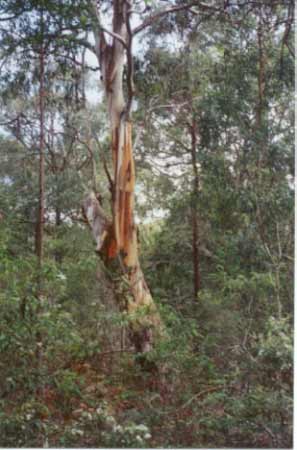
October 2001: Old growth inside Hancock plantation near Sutton Road.
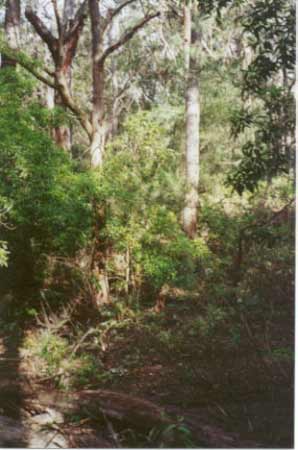
October 2001: Old growth inside Hancock plantation near Sutton Road.
Tarra River - Upper reaches: Fast flowing stream running through partly cleared hills, rock and gravel bottom. Access is good but the tributaries are remote and difficult to reach. Abundant brown trout to 400g, average 120g, river blackfish, tupong, grayling and eels. Subject to a blackfish closure.
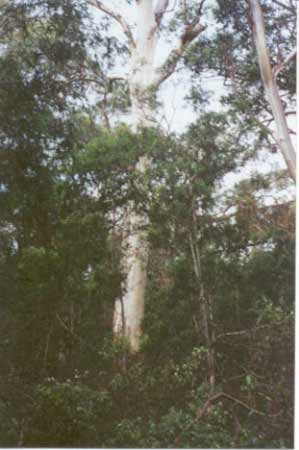
October 2001: Old growth inside supposed Hancock plantation.
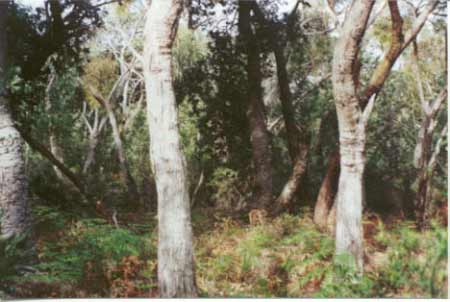
October 2001: Native vegetation including Banksia near Sutton Road inside Hancock plantation.
Source: A Guide to the Inland Angling Waters of Victoria by BR Tunbridge, PL Rogan, CA Barnham. Department Conservation and Environment. Arthur Rylah Institute for Environmental Research, 123 Brown St, Heidelberg, 3084. (4th ed - 1991).